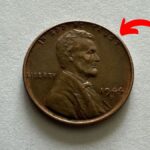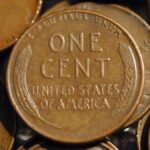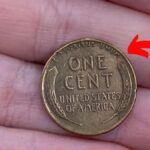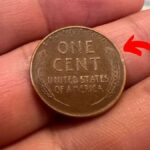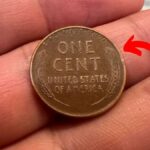The Lincoln Wheat Penny Valued at $4 Billion: For many people, coins are just pocket change. But in the fascinating world of rare coin collecting, certain pieces can be worth staggering amounts of money. Let’s explore three extraordinary coins that have captured the imagination of collectors worldwide: the 1894-S Barber Dime, the 1913 Liberty Head V Nickel, and the 1976 Bicentennial Quarter.
The Mysterious Barber Dime
The 1894-S Barber Dime stands as one of the most intriguing coins ever minted in American history. Only 24 of these dimes were ever created at the San Francisco Mint, making them incredibly rare. Today, coin experts believe that only nine or ten of these dimes still exist, which explains their astronomical value. In 2016, one of these dimes made headlines when it sold for $1.9 million at auction – an incredible price for such a tiny piece of metal.
What makes this coin’s story even more fascinating is that it was never meant to be circulated among the public. The San Francisco Mint created these dimes for a specific purpose, though the exact reason remains debated among historians. Some believe they were made as gifts for bank officials, while others think they were struck to balance the mint’s annual accounts.
The Legendary Liberty Head Nickel
Even rarer than the Barber Dime is the 1913 Liberty Head V Nickel. With only five known examples in existence, this coin represents the pinnacle of American numismatics (the study and collection of coins). Its creation is shrouded in mystery because the U.S. Mint had officially stopped producing Liberty Head nickels in 1912, switching to the Buffalo nickel design in 1913.
The story behind these five nickels adds to their allure. They were allegedly struck in secret by Samuel Brown, a former mint employee, though this has never been definitively proven. The coins didn’t surface until Brown displayed them at a coin collector’s convention in 1920. Since then, they’ve become legendary among collectors, with one selling for a remarkable $4.56 million in 2018.
A Modern Treasure: The Bicentennial Quarter
While not as old as its counterparts, the 1976 Bicentennial Quarter holds its own special place in American coin history. Created to celebrate America’s 200th birthday, these quarters featured a unique reverse design showing a Colonial drummer alongside the dates 1776-1976. While millions were made for circulation, certain rare versions have become highly valuable, particularly those in perfect condition.
What sets some Bicentennial quarters apart is their quality and preservation. A particularly well-preserved example sold for $11,100 at auction in 2020, showing that even relatively modern coins can achieve impressive values when they’re in exceptional condition. While the suggested $4 billion value mentioned for these quarters is highly speculative, they remain popular among collectors for their historical significance and distinctive design.
Understanding Coin Values
The reported $4 billion valuations for these coins should be understood as theoretical rather than actual market prices. Coin values are determined by several key factors: rarity, condition, historical significance, and market demand. While the Barber Dime and Liberty Head Nickel have proven their worth through million-dollar sales, their actual value at any given time depends on what collectors are willing to pay.
The condition of a coin, graded on a standardized scale, can dramatically affect its worth. Coins in “mint” condition – those that appear as fresh as the day they were struck – command the highest prices. Even minor wear or damage can significantly reduce a coin’s value, which is why proper preservation is crucial for serious collectors.
Historical Context Matters
Each of these coins tells a unique story about American history. The Barber Dime represents the late 19th century’s classical coin designs, named after Chief Engraver Charles E. Barber. The Liberty Head Nickel captures a moment of transition in American coinage, while the Bicentennial Quarter commemorates a pivotal celebration in our nation’s history.
The historical context of these coins adds layers to their value beyond mere rarity. They serve as tangible connections to different eras of American history, preserving artistic and cultural elements of their times. This historical significance makes them particularly appealing to collectors who appreciate both their monetary and cultural value.
The World of Coin Collecting Today
Modern coin collecting has evolved into a sophisticated hobby combining investment potential with historical appreciation. Professional grading services now authenticate and grade coins, providing standardized assessments that help determine their value. This has brought more stability and credibility to the rare coin market.
Serious collectors often focus on building complete sets of particular coin series or collecting pieces from specific historical periods. Others concentrate on acquiring the highest-quality examples they can find, regardless of the type of coin. The hunt for rare pieces like the Barber Dime or Liberty Head Nickel continues to drive excitement in the collecting community.
Lessons for Aspiring Collectors
For those interested in coin collecting, these famous examples offer important lessons. First, condition is crucial – even common coins in exceptional condition can be valuable. Second, understanding a coin’s historical context and rarity can help in making informed collecting decisions. Finally, patience and research are essential, as building a significant collection takes time and knowledge.
While finding a billion-dollar coin might be unlikely, many valuable coins are still discovered in circulation or old collections. Careful study of coin history, grading standards, and market values can help collectors identify potentially valuable pieces.
Looking to the Future
The future of rare coin collecting remains bright, with values for exceptional pieces continuing to rise. Digital technology has made it easier for collectors to research and authenticate coins, while online auctions have expanded the market globally. The stories of the Barber Dime, Liberty Head Nickel, and Bicentennial Quarter remind us that coins can be more than currency – they can be windows into history and potentially valuable investments.
As new generations discover the appeal of coin collecting, these rare pieces will likely continue to capture imaginations and command impressive prices. While their billion-dollar valuations might be more dream than reality, their status as numismatic treasures is firmly established in the collecting world.


